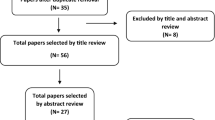Abstract
Purpose
This is a pilot study which aims to evaluate the accuracy of cone-beam computed tomography (CBCT) to assess the configuration and extent of ligature-induced peri-implantitis defects.
Materials and methods
Radiographic evaluation of advanced ligature-induced peri-implantitis defects (n = 9) in canine was performed using CBCT (central cross-sections) and compared with the corresponding histomorphometrical measurements of the respective site serving as a validation method. Deviations were calculated for the supracrestal (SC), and intrabony (IC) defect components, as well as defect width (DW) assessed at both vestibular (v) and oral (o) aspects.
Results
Mean differences between CBCT and histological analyses were −0.53 ± 1.48 mm (SC), +0.49 ± 1.18 mm (IC), and +0.18 ± 0.54 mm (DW) at vestibular aspects, and −0.13 ± 0.44 mm (SC), −0.05 ± 0.62 mm (IC), and +0.15 ± 0.48 mm (DW) at the oral aspects (P > 0.05; paired t test, respectively).
Conclusion
CBCT may represent an accurate diagnostic tool to estimate the histological extent of advanced peri-implantitis defects.

Similar content being viewed by others
References
Heitz-Mayfield LJ (2008) Peri-implant diseases: diagnosis and risk indicators. J Clin Periodontol 35(8 Suppl):292–304
Lang NP, Berglundh T (2011) Periimplant diseases: where are we now? Consensus of the Seventh European Workshop on Periodontology. J Clin Periodontol 38(Suppl 11):178–181
Roos-Jansaker AM, Lindahl C, Persson GR, Renvert S (2011) Long-term stability of surgical bone regenerative procedures of peri-implantitis lesions in a prospective case–control study over 3 years. J Clin Periodontol 38(6):590–597
Schwarz F, Sahm N, Bieling K, Becker J (2009) Surgical regenerative treatment of peri-implantitis lesions using a nanocrystalline hydroxyapatite or a natural bone mineral in combination with a collagen membrane: a four-year clinical follow-up report. J Clin Periodontol 36(9):807–814
Schwarz F, Jepsen S, Herten M, Sager M, Rothamel D, Becker J (2006) Influence of different treatment approaches on non-submerged and submerged healing of ligature induced peri-implantitis lesions: an experimental study in dogs. J Clin Periodontol 33(8):584–595
Schwarz F, Herten M, Sager M, Bieling K, Sculean A, Becker J (2007) Comparison of naturally occurring and ligature-induced peri-implantitis bone defects in humans and dogs. Clin Oral Implants Res 18(2):161–170
Schwarz F, Sahm N, Schwarz K, Becker J (2010) Impact of defect configuration on the clinical outcome following surgical regenerative therapy of peri-implantitis. J Clin Periodontol 37(5):449–455
Mengel R, Kruse B, Flores-de-Jacoby L (2006) Digital volume tomography in the diagnosis of peri-implant defects: an in vitro study on native pig mandibles. J Periodontol 77(7):1234–1241
Schwarz F, Sahm N, Mihatovic I, Golubovic V, Becker J (2011) Surgical therapy of advanced ligature-induced peri-implantitis defects: cone-beam computed tomographic and histological analysis. J Clin Periodontol 38(10):939–949
Fienitz T, Schwarz F, Ritter L, Dreiseidler T, Becker J, Rothamel D (2011) Accuracy of cone beam computed tomography in assessing peri-implant bone defect regeneration: a histologically controlled study in dogs. Clin Oral Implants Res. doi:10.1111/j.1600-0501.2011.02232.x
Lindhe J, Berglundh T, Ericsson I, Liljenberg B, Marinello C (1992) Experimental breakdown of peri-implant and periodontal tissues. A study in the beagle dog. Clin Oral Implants Res 3(1):9–16
Razavi T, Palmer RM, Davies J, Wilson R, Palmer PJ (2010) Accuracy of measuring the cortical bone thickness adjacent to dental implants using cone beam computed tomography. Clin Oral Implants Res 21(7):718–725
Schulze RK, Berndt D, d’Hoedt B (2010) On cone-beam computed tomography artifacts induced by titanium implants. Clin Oral Implants Res 21(1):100–107
Farman AG, Scarfe WC (2008) What is cone-beam CT and how does it work? Dent Clin North Am 52:707–730
Acknowledgments
We kindly appreciate the skills and commitment of Mrs Hartig, Mr Kaiser, and Mr Lommen (Department of Oral Surgery, Heinrich Heine University, Düsseldorf, Germany) in the preparation of the histological specimens.
Source of funding
The study was funded by the Osteology Foundation, Lucerne, Switzerland and the Camlog Foundation, Basel, Switzerland. The study materials and devices were kindly provided by Camlog Biotechnologies AG, Basel, Switzerland and Orangedental, Biberach, Germany.
Author information
Authors and Affiliations
Corresponding author
Rights and permissions
About this article
Cite this article
Golubovic, V., Mihatovic, I., Becker, J. et al. Accuracy of cone-beam computed tomography to assess the configuration and extent of ligature-induced peri-implantitis defects. A pilot study. Oral Maxillofac Surg 16, 349–354 (2012). https://doi.org/10.1007/s10006-012-0320-2
Received:
Accepted:
Published:
Issue Date:
DOI: https://doi.org/10.1007/s10006-012-0320-2




